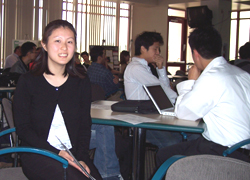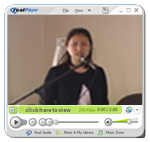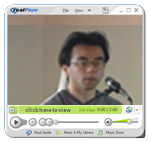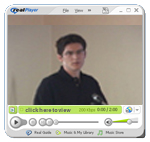Electrical Engineering Undergrads Supported by Calit2 Shine at Research Showcase
April 22, 2005 / By Doug Ramsey
|
4.22.05 -- Five teams of undergraduate electrical and computer engineering students at UCSD sponsored by Calit2 took part in the 6th annual research showcase known as EUREKA 2005, and two of the three top awards went to researchers sponsored by the institute.
The showcase on April 18 was co-sponsored by the Jacobs School of Engineering's Electrical and Computer Engineering (ECE) department, its Corporate Affiliates Program (CAP), and Lockheed Martin. The acronym stands for ECE's Undergraduate REsearch Konference & Assembly, and the presentations and posters were all by ECE undergraduates.
In all, 15 teams made presentations to a crowd of roughly 100 people who attended the conference and lunch. Of those, five presentations were about research projects sponsored by Calit2 as part of its summer undergraduate research program or its funding for ECE project courses such as ECE 191.
|
Jenny Hu won the top individual prize for her work with professor S.S. Lau on physical and electrical properties of InP nanowires. Hu was a Calit2
|
undergraduate scholar last summer. Another individual project sponsored by Calit2 was Warren Mar's work with professor Ed Yu analyzing and designing novel optoelectronic devices.
Three other projects sponsored by Calit2 were team endeavors. The EUREKA award for the most creative project went to Mark Noah and Robert Romabiles for their development of a cellular-based GPS shuttle tracker. The team has worked for the past two quarters on the technology with funding from Calit2 and guidance from mentor John Zhu, a staff researcher in Calit2. The team is now looking for further
|
funding to deploy their system on the UCSD campus, where students would be able to keep track of where campus shuttle buses are -- just by looking at their cell phone.
|
Jeff Pon made a presentation on behalf of his team-mates Chintan Sheth, Hardik Desai and Pritesh Patel. They all worked with Calit2 researcher Doug Palmer to design a small, power-efficient display to be incorporated into a Wi-Fi-enabled pulse oximeter to monitor the vital signs of victims in the event of a disaster. It's part of a wider project known as WIISARD, which stands for Wireless Internet Information System for Medical Response in Disasters.
Separately, a team mentored by Calit2 researcher Paul Blair presented the results of their work on a Bluetooth differential GPS receiver and navigator. Mark Barry, Yi-Chen Wu and Justin Fields worked on the project, with Barry making the presentation to EUREKA attendees.
|
The keynote talk at the conference was delivered by Michael LaRouche, General Manager of Lockheed Martin Maritime Systems and Sensors. His topic: leadership in engineering. He hailed the experience students get working on projects of the school's Teams in Engineering Service (TIES) program, as outlined by TIES project director Silvia Mah at the event. TIES gives undergrads hands-on experience with team engineering projects for community partners, and is supported in part by Calit2.
[Click here to view Mah's presentation in streaming Real video.]ECE professors Charles Tu and Pankaj Das organized the EUREKA event with CAP director Anne O'Donnell and senior Yan Zheng. "This was our most successful event to date," said Tu. "More than 100 people turned out to participate in this year's conference and assembly, and next year we hope to expand the event and invite undergraduate researchers from other Jacobs School departments as well."
To watch all 15 student presentations at EUREKA, click here .
Related Links
EUREKA
TIES
WIISARD
Related Articles
UCSD Engineering Students Showcase Real-World Group Design Projects
Media Contacts Media Contact: Doug Ramsey, (858) 822-5825, dramsey@ucsd.edu







